Hemorrhagic Stroke vs. Brain Clot: A Guide to Causes, Symptoms, and Recovery
Know about the haemorrhagic stroke vs brain clot, causes, symptoms, diagnosis, treatment options and more.

_0.webp?tr=q-80,f-webp,w-350,dpr-2,c-at_max 700w)
Introduction
A sudden, severe headache, unlike anything you've ever felt. Weakness on one side of your body. Slurred speech. These terrifying signs can point to a "brain attack," or stroke, a medical emergency where every second counts. But not all strokes are the same. Understanding the critical difference between a hemorrhagic stroke (a burst blood vessel causing bleeding in the brain) and an ischemic stroke (a blood clot blocking a brain artery) is crucial. This guide will demystify these conditions, focusing particularly on the causes, symptoms, and recovery path for a hemorrhagic stroke. We'll equip you with the knowledge to recognise the warning signs, understand the diagnostic process, and grasp the principles of treatment and prevention, empowering you to act fast and make informed decisions about brain health.
What is a Stroke? The Two Main Types
A stroke, clinically known as a cerebrovascular accident (CVA), occurs when the blood supply to a part of the brain is interrupted or reduced, preventing brain tissue from getting oxygen and nutrients. Brain cells begin to die within minutes. There are two primary mechanisms for this to happen.
Health topic carousel:
Doctor speciality: Neurologist
Text: Consult a Top Neurologist for Personalised Advice
Ischemic Stroke: The Brain Clot
An ischemic stroke accounts for about 87% of all strokes. It happens when a blood clot (thrombus) blocks an artery supplying blood to the brain. The clot can form directly in the brain's arteries (thrombotic stroke) or travel from elsewhere in the body, such as the heart, and lodge in a narrower brain artery (embolic stroke). The result is a blockage that starves downstream brain cells of oxygen.
Hemorrhagic Stroke: The Brain Bleed
A hemorrhagic stroke is less common but often more deadly. It occurs when a weakened blood vessel in the brain ruptures and bleeds into the surrounding tissue. The accumulated blood pools, creating pressure on the brain structures, which damages them. This bleeding can happen inside the brain tissue itself or in the spaces surrounding the brain.
A Key Difference: Opposite Causes, Similar Symptoms
This is the critical distinction: an ischemic stroke is caused by a blockage (a clot), while a hemorrhagic stroke is caused by a rupture (a bleed). This is why treatment is so different; a clot-busting drug used for an ischemic stroke could be catastrophic for a hemorrhagic one, as it would worsen the bleeding. Despite opposite causes, the symptoms can be identical because both events result in brain cell damage, making immediate medical imaging essential for a correct diagnosis.
Delving Deeper into Hemorrhagic Stroke
A hemorrhagic stroke is a complex event, and its specific location and cause significantly influence the treatment approach and prognosis.
Primary Causes of a Brain Bleed
The two main types of hemorrhagic stroke are classified by where the bleeding occurs.
Intracerebral Haemorrhage: Bleeding Within the Brain
This is the most common type of hemorrhagic stroke. It involves bleeding directly into the brain parenchyma (the functional tissue). The most frequent cause is chronic high blood pressure (hypertension), which weakens small arteries deep within the brain over time, making them prone to rupture. Other causes include trauma, blood-thinning medications, and amyloid angiopathy (a condition where protein builds up in artery walls, common in older adults).
Subarachnoid Haemorrhage: Bleeding on the Brain's Surface
This type involves bleeding into the subarachnoid space, the area between the brain and the thin tissues that cover it. The leading cause is the rupture of a cerebral aneurysm, which is a weak, bulging spot on a brain artery. An arteriovenous malformation (AVM), a tangle of faulty blood vessels connecting arteries and veins, can also cause this type of bleed.
Major Risk Factors You Should Know
Certain factors significantly increase the likelihood of experiencing a hemorrhagic stroke. The most significant is uncontrolled high blood pressure. Other key risk factors include smoking, which damages blood vessels; excessive alcohol consumption; use of illicit drugs like cocaine; conditions that cause bleeding tendencies; and the use of anticoagulant medications (blood thinners). Age and a family history of stroke or aneurysms also play a role.
Recognising the Signs: Symptoms of a Brain Attack
Time is brain. Recognizing the symptoms of a stroke, whether from a clot or a bleed, is the first and most critical step in seeking help.
The FAST Acronym: A Lifesaving Tool
The FAST acronym is a simple way to remember the sudden signs of a stroke:
Face: Ask the person to smile. Does one side of the face droop?
Arms: Ask the person to raise both arms. Does one arm drift downward?
Speech: Ask the person to repeat a simple phrase. Is their speech slurred or strange?
Time: If you observe any of these signs, call emergency services immediately. Note the time when symptoms first appeared.
Additional Symptoms Specific to Hemorrhagic Stroke
While FAST symptoms are common to both types, a hemorrhagic stroke may present with more severe or specific symptoms due to the increased pressure inside the skull. These can include:
A sudden, extremely severe headache, often described as a "thunderclap" or the worst headache of one's life.
Nausea and vomiting.
Seizures.
Loss of consciousness or decreased level of alertness.
Sensitivity to light (photophobia).
Neck stiffness.
If you or someone near you experiences a sudden, severe headache along with any other stroke symptoms, it is a red flag for a potential hemorrhagic stroke.
Getting a Diagnosis: How Doctors Identify the Problem
In the emergency room, speed and accuracy are paramount. The primary goal is to quickly determine the type of stroke.
Immediate Brain Imaging: CT Scan and MRI
A non-contrast computed tomography (CT) scan is usually the first test performed. It can quickly distinguish between an ischemic stroke and a hemorrhagic stroke by clearly showing fresh blood in the brain. In some cases, a Magnetic Resonance Imaging (MRI) scan may be used for a more detailed view of the brain tissue and to identify the precise location and extent of the bleed.
Further Investigations: Angiograms and Other Tests
Once a bleed is confirmed, doctors need to find its source. A CT or MR angiogram may be performed, which involves injecting a contrast dye into the blood vessels to visualise the arteries in the brain and identify an aneurysm or AVM. Other tests may include blood tests to check for clotting factors and a lumbar puncture (spinal tap) if a subarachnoid haemorrhage is suspected but not clearly visible on the CT scan. If you are experiencing persistent neurological symptoms, consulting a neurologist online with Apollo24|7 can be a good first step to discuss the need for such diagnostic tests.
Emergency Treatment and Long-Term Management
Treatment for a hemorrhagic stroke focuses on controlling the bleeding, reducing pressure on the brain, and stabilising the patient.
The Golden Hour: Immediate Medical Response
The first few hours are critical. Emergency treatment involves managing blood pressure to prevent further bleeding, administering medications to counteract any blood thinners the patient may be taking, and using drugs to reduce brain swelling and prevent seizures.
Surgical Interventions for a Brain Bleed
Depending on the size, location, and cause of the bleed, surgery may be necessary.
Surgical Clipping: A neurosurgeon places a tiny clip at the base of an aneurysm to stop blood flow into it and prevent re-bleeding.
Endovascular Coiling: A less invasive procedure where a catheter is threaded from the groin to the brain arteries. Platinum coils are then inserted into the aneurysm, promoting blood clotting and sealing it off.
Hematoma Evacuation: For a large intracerebral haemorrhage, surgery may be performed to remove the blood clot (hematoma) and relieve pressure on the brain.
The Road to Recovery: Rehabilitation Therapies
Recovery is a long-term process that begins once the patient is stable. Rehabilitation aims to help survivors regain as much independence as possible. This typically involves a team of specialists and includes:
Physical Therapy: To improve strength, balance, and coordination.
Occupational Therapy: To relearn daily activities like dressing, eating, and bathing.
Speech Therapy: To address problems with speaking, understanding, and swallowing.
The extent of recovery varies greatly from person to person and depends on the severity of the stroke.
Can a Hemorrhagic Stroke Be Prevented?
While not all strokes are preventable, a significant number can be avoided by managing risk factors.
Managing Key Risk Factors
The single most important step is to control high blood pressure. This involves regular monitoring, adhering to prescribed medications, and maintaining a healthy diet low in sodium. If you are on blood thinners, regular monitoring is essential to ensure the dosage is correct and not increasing your risk of bleeding. Apollo24|7 offers convenient home collection for tests like INR (to monitor blood thinner levels), making it easier to manage your condition.
The Importance of Lifestyle Changes
Adopting a heart-healthy lifestyle dramatically reduces stroke risk. This includes:
Eating a balanced diet rich in fruits, vegetables, and whole grains.
Engaging in regular physical activity.
Maintaining a healthy weight.
Avoiding smoking and limiting alcohol consumption.
Managing stress effectively.
Conclusion
A hemorrhagic stroke is a life-altering event, but understanding its causes, symptoms, and treatments empowers you to act decisively. Recognising the signs using the FAST acronym and seeking immediate medical attention can save a life and significantly improve the chances of recovery. While the journey to recovery can be challenging, modern medicine and dedicated rehabilitation offer hope and the potential for a meaningful life post-stroke. Stay informed, listen to your body, and prioritise your brain health. If you have concerns about your stroke risk factors, such as high blood pressure, consider consulting a doctor online with Apollo24|7 for personalised advice and a management plan.
Health topic carousel:
Doctor speciality: Neurologist
Text: Consult a Top Neurologist for Personalised Advice
Frequently Asked Questions
1. What is the survival rate for a hemorrhagic stroke?
A.The survival rate depends on the bleed's size, location, and how quickly treatment is received. While hemorrhagic strokes are often more severe than ischemic ones, many people do survive. Immediate medical care is the most critical factor for survival and recovery.
2. Can a person fully recover from a brain haemorrhage?
A.Full recovery is possible but not guaranteed. The extent of recovery depends on the area of the brain affected and the amount of damage. Many survivors make significant improvements through intensive rehabilitation, but some may experience long-term physical, cognitive, or emotional challenges.
3. What are the long-term effects of bleeding in the brain?
A.Long-term effects can vary widely but may include paralysis or weakness on one side of the body (hemiparesis), difficulty speaking (aphasia), memory problems, emotional changes, and chronic pain. Rehabilitation therapy is crucial for managing these effects.
4. How is a hemorrhagic stroke different from an aneurysm?
A.An aneurysm is a weak, bulging spot on a blood vessel wall—a potential cause. A hemorrhagic stroke is the event that occurs if an aneurysm ruptures and bleeds. Not all aneurysms rupture, and many are found incidentally and monitored.
5. What should I do while waiting for the ambulance if I suspect a stroke?
A.Stay calm. Note the time symptoms started. Keep the person lying on their side (recovery position) if they are unconscious or vomiting, to prevent choking. Do not give them any food, drink, or medication. Be ready to tell emergency responders what happened and what medications the person takes.
Consult Top Specialists for Personalised Tips

Dr Debnath Dwaipayan
Neurosurgeon
9 Years • MBBS, MS(Gen. Surgery), DrNB (Neurosurgery)
Delhi
Apollo Hospitals Indraprastha, Delhi

Dr. Avinash Gupta
Neurologist
12 Years • MBBS, DNB - Neurology
Bilaspur
Apollo Hospitals Seepat Road, Bilaspur
(150+ Patients)
Dr. Lakshaman K
Neurologist
19 Years • MBBS,MS General Medicine,MCH Neurosurgery
Bengaluru
R V speciality Clinic, Bengaluru

Dr. Ganeshgouda Majigoudra
Neurologist
10 Years • MBBS, MD ( GENERAL MEDICINE) DM (NEUROLOGY)
Bengaluru
Apollo Clinic, JP nagar, Bengaluru

Dr. Aditendraditya Singh Bhati
Neurosurgeon
18 Years • MBBS(2004), DNB Neurosurgery(2014); MNAMS; Fellow Neuroendoscopy
Delhi
Apollo Hospitals Indraprastha, Delhi
(100+ Patients)
Consult Top Specialists

Dr Debnath Dwaipayan
Neurosurgeon
9 Years • MBBS, MS(Gen. Surgery), DrNB (Neurosurgery)
Delhi
Apollo Hospitals Indraprastha, Delhi

Dr. Avinash Gupta
Neurologist
12 Years • MBBS, DNB - Neurology
Bilaspur
Apollo Hospitals Seepat Road, Bilaspur
(150+ Patients)
Dr. Lakshaman K
Neurologist
19 Years • MBBS,MS General Medicine,MCH Neurosurgery
Bengaluru
R V speciality Clinic, Bengaluru

Dr. Ganeshgouda Majigoudra
Neurologist
10 Years • MBBS, MD ( GENERAL MEDICINE) DM (NEUROLOGY)
Bengaluru
Apollo Clinic, JP nagar, Bengaluru

Dr. Aditendraditya Singh Bhati
Neurosurgeon
18 Years • MBBS(2004), DNB Neurosurgery(2014); MNAMS; Fellow Neuroendoscopy
Delhi
Apollo Hospitals Indraprastha, Delhi
(100+ Patients)




